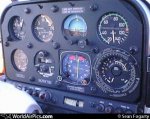StanFoster
Active Member
- Joined
- Nov 16, 2003
- Messages
- 17,139
- Location
- Paxton, Il
- Aircraft
- Helicycle N360SF
- Total Flight Time
- 1250
When I was making my landing gear fairings....I had to come up with a way to know how many degrees of collective pitch I was applying so that I could repeatedly fly at that same pitch on my data collecing runs. Recording the speed was a given with my GPS averaging groundspeed into and with the wind. I came up with putting a laser pointer on my collective and making a linear degree marking along my door channel.
The first two pictures show 10 and 13 degrees respectively. My linear layout goes from 7 degrees to 17 degrees.
This served its purpose well...but I soon realized how valuable having this information is. On hot humid days...full fuel...and can easily check my performance by hovering in ground effect and noting how many degrees of collective is required.
Just today I decided to do some data on how many degrees of collective it takes to hover over different surfaces. I find this very interesting to prove by actual demonstrations to myself, stuff I read about. Here is the data for HIGE and HOGE for todays already 92 degree high humidity temps.
HIGE asphalt surface 10.50 degrees
HIGE short grass 10.75 degrees
HIGE tall grass 11.0 degrees
HIGE soybeans medium height 11.25 degrees
HIGE tall corn 12.0 degrees
Hovering out of ground effect............12.25 degrees
Now...when those soybeans above reach full height..I expect them to be the biggest power suckers of all. The hovering over tall corn isnt really the same as I am already 10 feet in the air anyway.
But I never will forget during my R22 solo time....I landed down on my mowed lot and had a tall soybean field next to it. I did not have anything but manifolt pressure to watch, so I noted that while I hovered over the short grass.....then drifted over the tall beans without changing altitude. Talk about power sucking vegatation! I expected a necessary increase in collective to maintain my hover height as I went over the beans. The manifold pressure went up of course....but I had no direct pitch reading of my rotorblades like I do in my Helicycle.
I find this information very useful and every liftoff I fire the laser pointer and can instantly tell how much performance I have.
I also recorded my collective pitch setting while transitioning through translational lift which I will post in a thread of its own.
This stuff NEVER gets boring to me! Though I probably bore some with my obsessiveness to experience stuff I read.
The last picture shows some elevated but still very ok temps right after all my hovering tests.
Stan
The first two pictures show 10 and 13 degrees respectively. My linear layout goes from 7 degrees to 17 degrees.
This served its purpose well...but I soon realized how valuable having this information is. On hot humid days...full fuel...and can easily check my performance by hovering in ground effect and noting how many degrees of collective is required.
Just today I decided to do some data on how many degrees of collective it takes to hover over different surfaces. I find this very interesting to prove by actual demonstrations to myself, stuff I read about. Here is the data for HIGE and HOGE for todays already 92 degree high humidity temps.
HIGE asphalt surface 10.50 degrees
HIGE short grass 10.75 degrees
HIGE tall grass 11.0 degrees
HIGE soybeans medium height 11.25 degrees
HIGE tall corn 12.0 degrees
Hovering out of ground effect............12.25 degrees
Now...when those soybeans above reach full height..I expect them to be the biggest power suckers of all. The hovering over tall corn isnt really the same as I am already 10 feet in the air anyway.
But I never will forget during my R22 solo time....I landed down on my mowed lot and had a tall soybean field next to it. I did not have anything but manifolt pressure to watch, so I noted that while I hovered over the short grass.....then drifted over the tall beans without changing altitude. Talk about power sucking vegatation! I expected a necessary increase in collective to maintain my hover height as I went over the beans. The manifold pressure went up of course....but I had no direct pitch reading of my rotorblades like I do in my Helicycle.
I find this information very useful and every liftoff I fire the laser pointer and can instantly tell how much performance I have.
I also recorded my collective pitch setting while transitioning through translational lift which I will post in a thread of its own.
This stuff NEVER gets boring to me! Though I probably bore some with my obsessiveness to experience stuff I read.
The last picture shows some elevated but still very ok temps right after all my hovering tests.
Stan
Attachments
Last edited:









